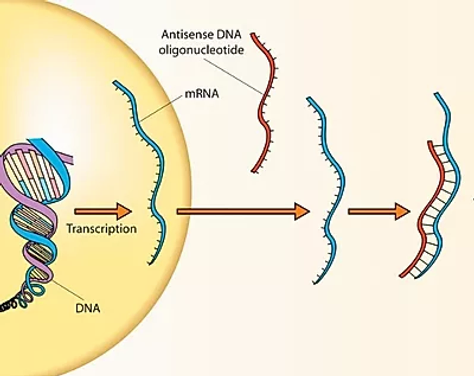
SOT Therapy
Supportive Oligonucleotide Therapy (SOT)
SOT is a treatment for Lyme, co-infections, and viruses like EBV, HSV, CMV, Varicella and more. This breakthrough therapy utilizes short DNA or RNA segments to block the expression of critical segments of genes needed for Lyme, co-infections, or viruses to survive and replicate.
Essentially SOT creates a shutoff “key” that precisely fits a chosen “lock” portion of a pathogen. The “lock” is a specific section of RNA that normally controls an important function of the pathogen. The “key” binds to the “lock” and blocks the function thus eliminating the pathogen. Afterward, the SOT compound is released and travels to the next target, thus fighting the infection 24/7 for 3 to 6 months.
The figure shows an example of a pathogen such as the Lyme bacteria. Inside the cell nucleus (yellow), bacterial DNA is used to transcribe messenger RNA (mRNA). The mRNA is sent out of the nucleus into the main part of the cell, the cytoplasm. It is there that mRNA is used to join amino acids together into essential proteins for a variety of activities, including reproduction. SOT works by creating a short segment of complementary RNA in the lab that binds to specific mRNA segments to prevent the organism from making these essential proteins, essentially shutting off replication. Unable to replicate, the organism is unable to cause disease.
Frequently asked questions
The top 2 practitioners in the US report a 96% success rate for Lyme Disease (Borrelia burgdorferi). RGCC says this as well, but has not published supporting data. For other organisms, SOTs are too new to know for sure. A patient's response to SOT depends on a variety of factors, including number of organisms involved and how long the infection(s) have been present.
Additional Information
This video explains SOT in visual detail. Though it describes SOT for cancer therapy rather than treatment of infections, the techniques are essentially the same. This Facebook group, S.O.T. for Lyme, EBV & Co-infections (supportive oligonucleotide therapy), is a great resource for additional information. Another good source is The Genesis Center's Lyme Page. Years of clinical experience from around the world are showing that long term suppression of treated viruses or Lyme is likely (but not guaranteed) and that symptoms associated with these diseases are usually greatly diminished or eliminated. SOT is not a drug in the traditional sense. It is not an antibiotic nor is it gene therapy. It does not change the genetic structure. There is no gene splicing, gene insertion, or manipulation. SOT therapy is a stealth technology with molecules so small that they are able to avoid detection and destruction by the immune system or RNA degrading enzymes for months, allowing them to quietly circulate through the body, attaching to their viral or bacterial targets.
SOT Protocol
To make a diagnosis of infection and/or to most accurately gauge response between SOT treatments, we recommend using either 1) Vibrant Labs or 2) PrimeSPOT or PaldiSPOT through RGCCs affiliate lab, Biocentaur. We offer both of these at our clinic. However, any confirmed infection through a recognized US lab within 6 months prior to ordering an SOT is sufficient to start therapy. The patient’s blood is drawn to obtain circulating Lyme bacteria or viruses. The blood is sent to RGCC laboratory in Greece. RGCC lab identifies the main genetic sequence of the target replication genes for the organism, then creates a complementary oligonucleotide (short nucleic acid) sequence to block replication. Four to six weeks after the initial blood draw in our clinic, RGCC ships the SOT to the our clinic where it is infused intravenously over about an hour. Intravenous antihistamines and low dose steroids are given immediately prior to SOT administration in order to lessen the already rare chance of an allergic reaction and tighten the vein walls to minimize leaking of the SOT. The main side-effects of SOT treatment are detox or "Herx" reactions, such as fatigue, body aches, and headache. Patients who have gone through treatment will often say “your symptoms get worse before they get better.” The SOT may be repeated up to 3x per year if needed. With each round of SOT it is recommended to retest for the presence of pathogens. At some point the infection may be completely eradicated or remain stable in a quiet remission.

